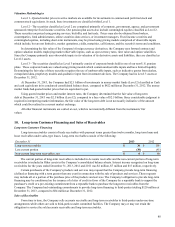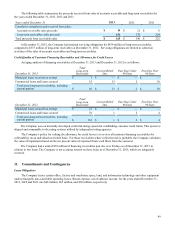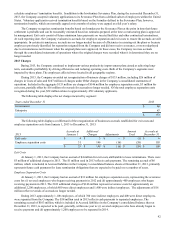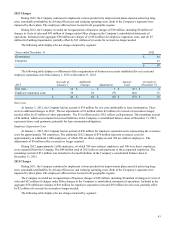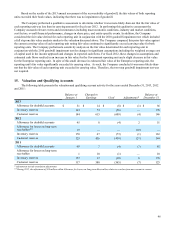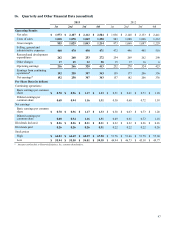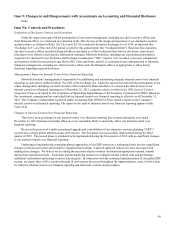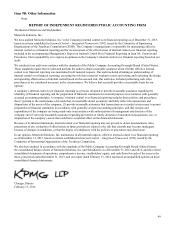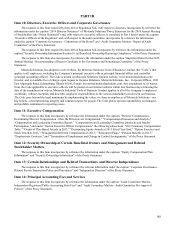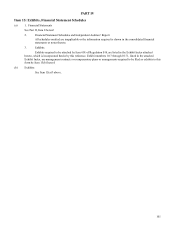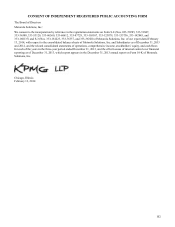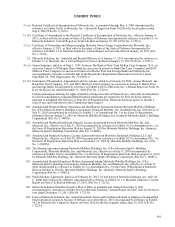Motorola 2013 Annual Report Download - page 100
Download and view the complete annual report
Please find page 100 of the 2013 Motorola annual report below. You can navigate through the pages in the report by either clicking on the pages listed below, or by using the keyword search tool below to find specific information within the annual report.98
Item 9: Changes in and Disagreements with Accountants on Accounting and Financial Disclosure
None.
Item 9A: Controls and Procedures
Evaluation of Disclosure Controls and Procedures.
Under the supervision and with the participation of our senior management, including our chief executive officer and
chief financial officer, we conducted an evaluation of the effectiveness of the design and operation of our disclosure controls
and procedures, as defined in Rules 13a-15(e) and 15d-15(e) under the Securities Exchange Act of 1934, as amended (the
“Exchange Act”), as of the end of the period covered by this annual report (the “Evaluation Date”). Based on this evaluation,
our chief executive officer and chief financial officer concluded as of the Evaluation Date that our disclosure controls and
procedures were effective such that the information relating to Motorola Solutions, including our consolidated subsidiaries,
required to be disclosed in our Securities and Exchange Commission (“SEC”) reports (i) is recorded, processed, summarized
and reported within the time periods specified in SEC rules and forms, and (ii) is accumulated and communicated to Motorola
Solutions’ management, including our chief executive officer and chief financial officer, as appropriate to allow timely
decisions regarding required disclosure.
Management’s Report on Internal Control Over Financial Reporting.
Motorola Solutions’ management is responsible for establishing and maintaining adequate internal control over financial
reporting as such term is defined in Rule 13a-15(f) of the Exchange Act. Under the supervision and with the participation of our
senior management, including our chief executive officer and chief financial officer, we assessed the effectiveness of our
internal control over financial reporting as of December 31, 2013, using the criteria set forth in the 1992 Internal Control—
Integrated Framework issued by the Committee of Sponsoring Organizations of the Treadway Commission (COSO). Based on
this assessment, management has concluded that our internal control over financial reporting is effective as of December 31,
2013. The Company’s independent registered public accounting firm, KPMG LLP, has issued a report on the Company’s
internal control over financial reporting. The report on the audit of internal control over financial reporting appears in this
Form 10-K.
Changes in Internal Control Over Financial Reporting.
There have been no changes in our internal control over financial reporting that occurred during the year ended
December 31, 2013 that have materially affected, or are reasonably likely to materially affect, our internal control over
financial reporting.
We are in the process of a multi-year phased upgrade and consolidation of our enterprise resource planning (“ERP”)
systems into a single global platform across our business. The first phase was successfully implemented during the third
quarter of 2012. The second phase is scheduled to be implemented during the first quarter of 2014 with no significant changes
to our internal controls over financial reporting.
Continuing to implement the remaining phased approaches of our ERP system on a widespread basis involves significant
changes in business processes and extensive organizational training. A phased approach reduces the risks associated with
making these changes. We believe we are taking the necessary steps to monitor and maintain appropriate internal controls
during these transition periods. Such steps include deploying resources to mitigate internal control risks and performing
additional verifications and testing to ensure data integrity. In connection with the continued implementation of our global ERP
system, we expect there will be certain redesigns of our business processes throughout the implementation, some of which may
be related to internal control over financial reporting and disclosure controls and procedures.


